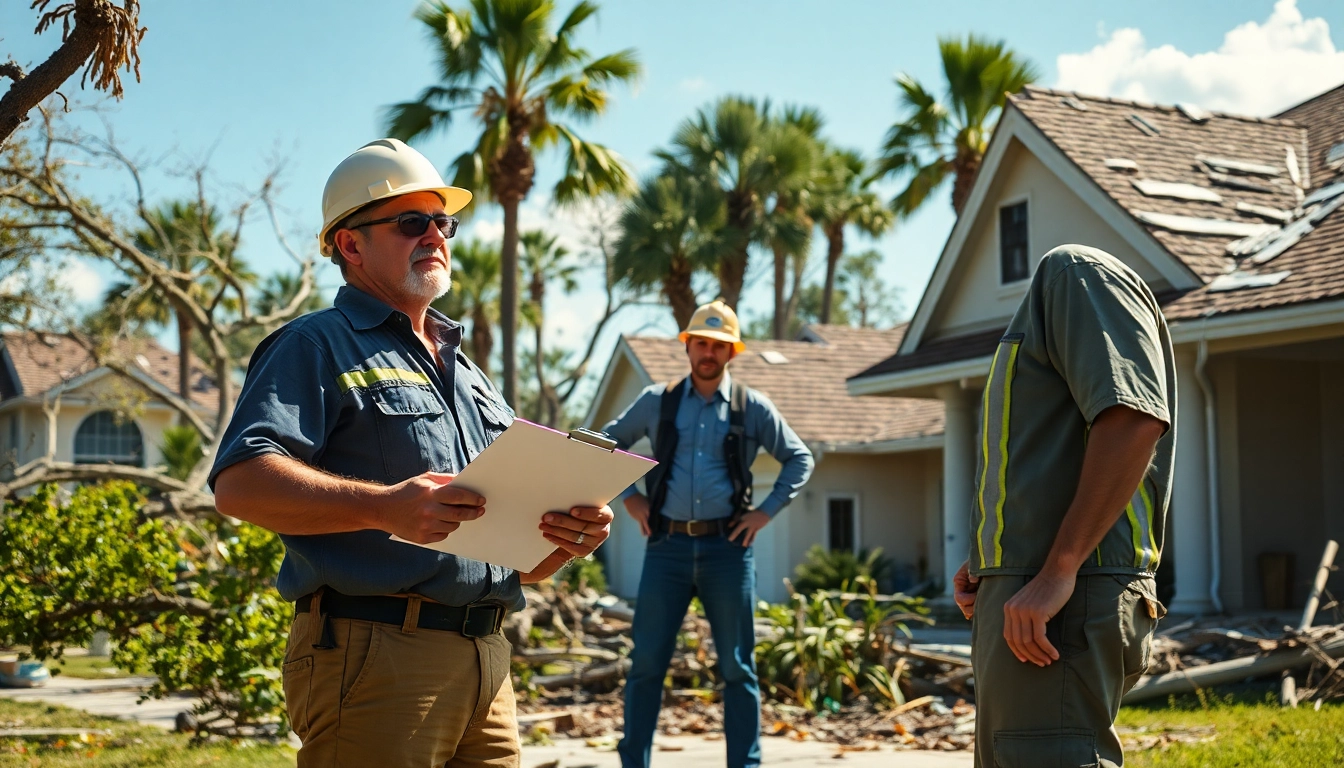Understanding Florida Hurricane Damage
Florida is renowned for its beautiful weather and stunning coastlines, but it also lies in one of the most hurricane-prone regions in the United States. This reality makes it essential for homeowners to comprehend the intricacies of Florida Hurricane Damage. Understanding the types of damage caused, the common areas affected, and the assessment process can help homeowners prepare and respond effectively when hurricanes strike.
Types of Damage Caused by Hurricanes
Hurricanes can cause extensive damage through multiple mechanisms. The following are the primary types of damage that can occur:
- Wind Damage: The high winds associated with hurricanes can cause severe damage to roofs, windows, and doors. Homes may experience shingle loss, compromised structural integrity, and broken windows.
- Flood Damage: Storm surges and heavy rainfall often lead to significant flooding. This can submerge properties, ruin possessions, and cause foundational issues.
- Debris Damage: Flying debris can result in both minor and severe impacts to homes. Items such as branches, signs, and outdoor furniture can cause puncture wounds and other forms of damage.
- Water Damage: In addition to flooding, water intrusion can occur through roof leaks, plumbing failures, and other breaches, leading to mold growth and structural damage if not addressed promptly.
- Long-term Damage: Prolonged exposure to the elements can cause decay. Homes that aren’t properly repaired after a hurricane may experience progressive deterioration, affecting resale value.
Common Areas Affected by Florida Hurricane Damage
Understanding which areas of your home are most susceptible to hurricane damage can guide both preparation and recovery efforts. Key areas include:
- Roofs: Roofs are often the first line of defense against hurricane winds. Damage here can lead to extensive water intrusion.
- Windows and Doors: Unprotected windows are particularly vulnerable to high winds and flying debris. They may shatter or be blown inwards.
- Exterior Walls: Siding, stucco, or other exterior materials can be damaged by wind and heavy rains, compromising insulation and waterproofing.
- Foundations: Flooding can undermine the foundation of a home, leading to settling and cracking that may require costly repairs.
- Basements: In flood-prone areas, basements can quickly fill with water, resulting in extensive cleanup and repair costs.
Assessment and Documentation of Damage
After a hurricane, assessing the damage involves a systematic process aimed at understanding the extent of destruction.
1. Safety First: Before assessing damage, ensure that the property is safe to enter. Look out for downed power lines, gas leaks, or compromised structures.
2. Visual Documentation: Use photos or videos to document the damage comprehensively. This documentation is crucial for insurance claims.
3. Inventory of Affected Items: Make a detailed list of damaged or destroyed belongings. Include descriptions, estimated values, and purchase dates if possible.
4. Professional Inspection: For a thorough assessment, consider hiring professionals to evaluate structural integrity and hidden damages.
5. Insurance Contact: Immediately contact your insurance provider to report the damages and start the claims process.
Preparing for Hurricane Season
Preparation can significantly reduce the impact of hurricane damage on your home and your family. Here are crucial steps to ensure you are ready for the hurricane season:
Creating a Home Emergency Plan
A well-thought-out emergency plan equips families with the knowledge to act before, during, and after a hurricane. Important components include:
- Emergency Contact List: Compile a contact list featuring local emergency services, family members, and friends.
- Evacuation Routes: Familiarize yourself with nearby evacuation routes and shelters. Practice these routes with your family.
- Communication Plan: Designate a point person to coordinate communication amongst family members during a storm.
- Special Needs Preparations: Consider the needs of elderly family members, pets, or anyone requiring medical assistance.
Investing in Home Insurance for Hurricane Coverage
Homeowners in Florida must invest in comprehensive homeowner’s insurance, including specific hurricane coverage. When selecting a policy, consider:
- Coverage Limits: Ensure that your policy covers the full replacement value of your home and belongings.
- Deductibles: Be aware of the hurricane deductible; it may be higher than standard deductibles, impacting your out-of-pocket costs.
- Additional Coverages: Explore optional coverages such as flood insurance, which is not included in many homeowner’s policies.
Essential Supplies for Hurricane Preparedness
Being prepared means having the right supplies on hand to sustain your family during and after a hurricane. A well-stocked emergency kit should include:
- Water: At least one gallon of water per person per day for at least three days.
- Food: Non-perishable food items enough to last at least three days.
- First Aid Kit: Include bandages, antiseptics, and necessary medications.
- Flashlights and Batteries: For power outages, ensure there are multiple flashlights and extra batteries.
- Multi-tool or Swiss Army Knife: A versatile tool can assist with various tasks during an emergency.
Steps to Take After Hurricane Damage
The aftermath of a hurricane can be overwhelming, but focusing on crucial steps can aid in recovery:
Initial Safety Precautions and Inspections
After a hurricane, the immediate focus should be on safety:
- Survey the Area: Before entering your home, check the vicinity for hazards like downed power lines or falling debris.
- Document Everything: Keep a detailed account of any visible damages for insurance purposes.
- Avoid Floodwaters: Stay clear of floodwaters to avoid contamination and other dangers.
Hiring Professionals for Damage Assessment
Engaging professionals can provide a thorough evaluation of damages:
- Structural Engineers: Can assess the safety of your home’s foundation and structure.
- Restoration Experts: Can identify hidden damage and mold growth.
- Adjusters: Insurance adjusters can assist in accurately assessing the damage for your claim.
Filing Insurance Claims for Florida Hurricane Damage
Filing an insurance claim after hurricane damage is crucial for recovery:
- Review Your Policy: Understand what damages are covered under your policy.
- Gather Documentation: Use your notes, photos, and any reports from inspectors to support your claim.
- Contact Your Insurer: Reach out to your insurance company promptly to initiate the claim process.
- Follow Up: Stay in contact with your adjuster and continue to provide them with any needed documentation.
Restoration and Recovery Options
Recovering from hurricane damage often involves significant restoration work. Homeowners should weigh their options carefully.
Choosing Between Repair and Replacement
A critical decision in the restoration process is determining whether to repair or replace damaged areas. Consider the following factors:
- Extent of Damage: Minor damage may warrant repairs, while severe damage may necessitate complete replacement.
- Cost Analysis: Evaluate the costs of repairs versus full replacement. Sometimes, repairs may be more economically feasible in the short term.
- Future Resilience: Select materials and techniques that will enhance the durability of your home against future storms.
Working with Contractors for Effective Restoration
Selecting qualified contractors is fundamental to successful restoration:
- Licensing and Insurance: Ensure contractors are licensed and insured to protect against liabilities.
- Check References: Ask for and check references or reviews from previous customers.
- Request Estimates: Get multiple quotes to compare both pricing and provided services.
Long-term Solutions for Hurricane Resilience
Investing in long-term resiliency measures can mitigate future hurricane damage:
- Reinforced Roofing: Opt for hurricane-rated roofing materials that can withstand high winds.
- Impact-Resistant Windows: Install shatterproof windows to minimize wind and debris damage.
- Elevated Landscaping: Modify landscaping to enhance drainage and reduce flooding risks.
Resources for Homeowners Facing Hurricane Damage
Homeowners navigating the complexities of hurricane damage can find numerous resources to assist them:
Government Assistance and Support Programs
Following a hurricane, various government programs may provide financial assistance and recovery resources. Be aware of programs like:
- FEMA Assistance: The Federal Emergency Management Agency offers disaster aid for households damaged in extreme weather conditions.
- State Resources: State housing authorities often have programs to assist with disaster recovery, including low-interest loans.
Community Organizations Helping Hurricane Victims
Local charities and organizations play a vital role in supporting hurricane recovery:
- American Red Cross: Provides shelters, food, and supplies during and after disasters.
- Local Non-profits: Often offer assistance with housing repairs, legal services, and mental health support.
Online Resources for Ongoing Education
Continuous education can help you stay prepared for future storms. Utilize these online resources:
- National Hurricane Center: Offers timely updates, forecasts, and safety information during hurricane season.
- Local Weather Services: Provide localized alerts and data for residents planning for severe weather.
- Preparedness Workshops: Many organizations host online workshops focusing on safety and recovery after disasters.




